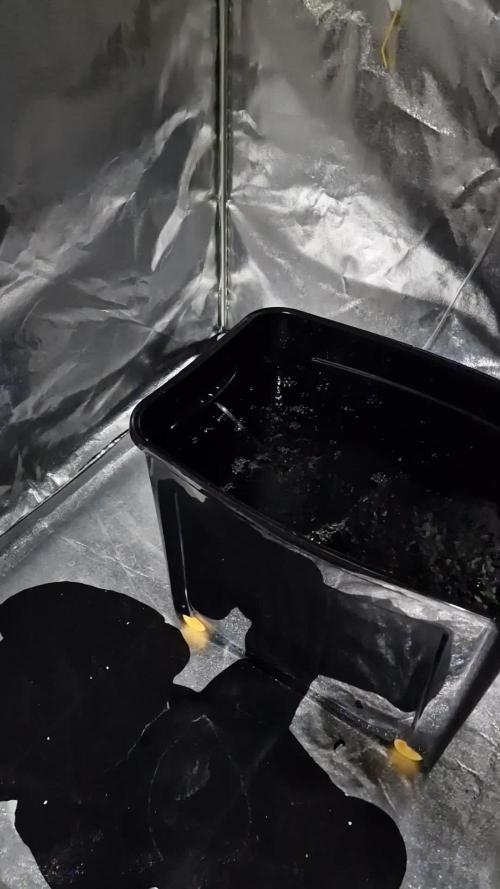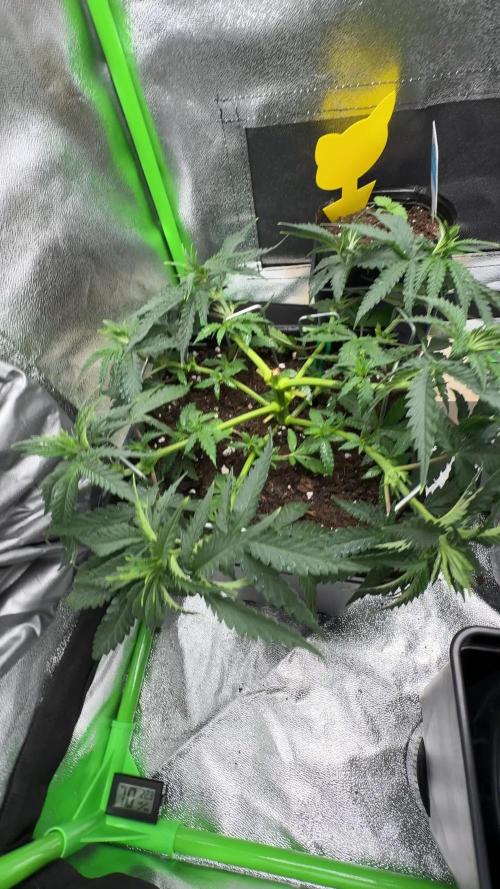The Grow Awards 2026 🏆 































Likes
Comments
Share


@Ultraviolet
Follow
Human Body
65% Oxygen (in all liquids and tissues, bones, and proteins)
18% Carbon (everywhere)
10% Hydrogen (in all liquids and tissues, bones, proteins
3% Nitrogen (in all liquids and tissues, proteins
1,5% Calcium (lungs, kidney, liver, thyroid, brain, muscles, heart, bones)
1% Phosphorus (urine, bones, DNA)
0,35% Potassium (enzymes)
0,25% Sulphur (proteins)
0,15% Sodium (in all liquids and tissues) (in terms of salt)
0,05% Magnesium (lungs, kidney, liver, thyroid, brain, muscles, heart)
The average adult male contains about 140 g of K(Potassium); the level varies with body weight and muscle mass. We ingest about 2.5 g per day of K from our food and excrete about the same amount. 0.0118 % of that is K40
The answer is that they were present when our earth was formed. Any radioactive material originally present at the formation of the earth would have decayed and disappeared if its half-life was short compared to the age of the earth. However, if its half-life were long, close to or greater than the age of the earth, then such materials would not have disappeared but are still with us today.
There are several radioelements in this category, such as the well-known elements uranium and thorium. Thorium (Th232) has a half-life of 14,000,000,000 years, uranium has two long-lived radioisotopes; U238 has a half-life of 4,500,000,000 years, and U235 has a half-life of 710,000,000 years. These give rise to the radium and thorium atoms found in all humans, acquired from the food we eat. That food, of course, obtained these materials from the soil in which it grew or on which it grazed.
Potassium is also in this category. There are actually three potassium isotopes: K39, a stable isotope, is the most abundant, at 93.26 % of the total; K41 is next in abundance at 6.73 % and is also a stable isotope. The potassium isotope of interest is a radioactive isotope, K40. It is present in all potassium at a very low concentration, 0.0118 %. It has a very long half-life, 1,260,000,000 years. When it decays 89 % of the events give rise to the emission of a beta ray with maximum energy of 1.33 MeV. The other 11 % of the decays produce a gamma-ray with an energy of 1.46 MeV
The forces required to forge thorium 232 can only be harnessed when traveling close to or at the speed of light, so essentially what I'm getting at is 0.0118% of every person alive is formed of the same element that was forged in the anvil of creation itself. We are all one & the same
German chemist Johann Wolfgang Dobereiner attempted to classify elements with similar properties into groups of three elements each. These groups were called ‘triads’. Dobereiner suggested that in these triads, the atomic mass of the element in the middle would be more or less equal to the mean of the atomic masses of the other two elements in the triad.
An example of such a triad would be one containing lithium, sodium, and potassium. The atomic mass of lithium 6.94 and that of potassium is 39.10. The element in the middle of this triad, sodium, has an atomic mass of 22.99 which is more or less equal to the mean of the atomic masses of lithium and potassium (which is 23.02). 9 controls the 6 and 3.
The Limitations of Dobereiner’s Triads are :
All the elements known at that time couldn’t be classified into triads.
Only four triads were mentioned – (Li,Na,K ), (Ca,Sr,Ba) , (Cl,Br,I) , (S,Se,Te).
2. Newland’s Octaves
English scientist John Newlands arranged the 56 known elements in increasing order of atomic mass in the year 1866. He observed a trend wherein every eighth element exhibited properties similar to the first.
Azomite contains 180ppm of thorium.
Your plant will thank you, you are welcome.
Most farmers do have not a proper understanding of what is Azomite and how to use it in gardening, especially if they practice organic farming. Continuous propagation and leaching effects of water deplete the essential minerals and micro-nutrients from the soils. Such soils remain weak, not able to support the production of fruits and vegetables. Azomite mineral contains micronutrients that supplement the soil. It also balances the minerals for growth and overall productivity. Constant use of this mineral rejuvenates your soil renewing its potency again. Azomite is a naturally mined mineral product that is ready to use. It’s a unique rock that comes from a mine in central Utah. Azomite requires no mixing or special preparation before use. It is derived from volcano ash that spewed out millions of years ago. It contains the widest range of minerals of all the rock dust in the world. Azomite provides plants with 70% essential elements. These elements include magnesium, calcium, potassium, and silicon for plant growth.
Facts About Azomite Fertilizer
It’s a natural mineral – 100% natural with no fillers or additives
Does not contain any harmful elements
Requires no special preparation before use
It’s odorless – very friendly to use
Does not restrict water penetration or aeration
Is easily broken down and absorbed into the soil
Does not burn plants.
READ ALL OF THIS, Magic is real:) Mag(net)ic has always been real.
Nuclear charge radii are sensitive probes of different aspects of the nucleon-nucleon interaction and the bulk properties of nuclear matter, providing a stringent test and challenge for nuclear theory. Experimental evidence suggested a new magic neutron number at N= 32 (refs. 1–3) in the calcium region, whereas the unexpectedly large increases in the charge radii4,5 open new questions about the evolution of nuclear size in neutron-rich systems. By combining the collinear resonance ionization spectroscopy method with β-decay detection, we were able to extend charge radii measurements of potassium isotopes beyond N= 32. Here we provide a charge radius measurement of 52K. It does not show a signature of magic behavior at N= 32 in potassium. The results are interpreted with two state-of-the-art nuclear theories. The coupled cluster theory reproduces the odd-even variations in charge radii but not the notable increase beyond N= 28. This rise is well captured by Fayans nuclear density functional theory, which, however, overestimates the odd-even staggering effect in charge radii. These findings highlight our limited understanding of the nuclear size of neutron-rich systems and expose problems that are present in some of the best current models of nuclear theory.
The charge radius is a fundamental property of the atomic nucleus. Although it globally scales with the nuclear mass as A1/3, the nuclear charge radius also exhibits appreciable isotopic variations that are the result of complex interactions between protons and neutrons. Indeed, charge radii reflect various nuclear structure phenomena such as halo structures6, shape staggering7, and shape coexistence8, pairing correlations9,10, neutron skins11, and the occurrence of nuclear magic numbers5,12,13. The term ‘magic number’ refers to the number of protons or neutrons corresponding to completely filled shells. In charge radii, a shell closure is observed as a sudden increase in the charge radius of the isotope just beyond magic shell closure, as seen, for example, at the well-known magic numbers N=28, 50, 82, and 126 (refs. 5,12–14).In the nuclear mass region near potassium, the isotopes with proton number Z≈20 and neutron number N=32 are proposed to be magic on the basis of an observed sudden decrease in their binding energy beyond N=32 (refs. 2,3) and the high excitation energy of the first excited state in 52Ca (ref. 1). Therefore, the experimentally observed a strong increase in the charge radii of calcium4 and potassium5
isotopes between N=28 and N=32, and in particular the large radius of 51K and 52Ca (both having 32 neutrons), have attracted substantial attention. One aim of the present study is therefore to shed light on several open questions in this region: how does the nuclear size of very neutron-rich nuclei evolve, and is there any evidence for the magicity of N=32 from nuclear size measurements? We furthermore provide new data to test several newly developed nuclear models, which aim to understand the evolution of nuclear charge radii of
exotic isotopes with large neutron-to-proton imbalances. So far, abinitio nuclear methods, allowing for systematically improvable calculations based on realistic Hamiltonians with nucleon-nucleon and three-nucleon potentials, have failed to explain the enhanced nuclear sizes beyond N=28 in the calcium isotopes4,15. Meanwhile, nuclear density functional theory (DFT) using Fayans functionals has been successful in predicting the increase in the charge radii of isotopes in the proton-magic calcium chain10, as well as the kinks in proton-magic tin and lead12. All these theoretical approaches have, until now, been predominantly used to study the charge radii of even-Z isotopes. Here they will be applied to the odd-Z potassium isotopes (Z=19).
https://www.nature.com/articles/s41567-020-01136-5
Processing
Likes
62
Share


@OwlGang_Uk
Follow
Week 6 - The Purple Power Is No Longer The Tallest In The Forest But It’s Still The Prettiest. The Purple Power Has Been Dethroned By 4 Of The Other Plants. Everyone Except For The Gorilla Glue Is On Bloom Nutrients.
Height:
Gorilla Glue: 19 Inches
Purple Power: 28 1/2 inches
Girls Scout Cookies(3gal): 30 inches
Lemon OG: 34 1/2 inches
Girls Scout Cookies(5gal): 34 1/2 inches
Stardawg: 33 1/2 inches
These Plants Are All Correct Measurements Size May Look Different In Picture Because Of Pot Size.
Likes
34
Share


@AsNoriu
Follow
Day 85. All is good, could be a bit better, but no care brings such things ...
AK's all grow like twins, solid and strong 40-50 g plants. I like them.
Og's : one is violet and big, great plant. One is very small, one is okeish. Very variable strain, lets see how different product will be ..
Happy Growing !!!
Likes
13
Share


@XperencdGmanXG
Follow
my first auto plant. Hoping it finishes quickly so i can have something to smoke b4 the outdoor crop is ready. Keep fingers crossed it does not just flop into flower right now.
Likes
Comments
Share


@naughtydog420
Follow
For vegetative stage I kept the lights on for 20 hours and off for 4 and then at the first sign of trigger I set hed the lighting to 12/12 I used pre amendment soil so there was no need to add nutrients the plant was in a city slicker sub irrigated planter that I would refill when empty this was my first time growing in a sub irrigated planter and it most definitely will not be the last this planter rocks out to say the least only regret is that I didn't buy more of them as for the smoke report I'll try and do an update I'll be drying for 16 days at 60 degrees Fahrenheit and 50% humidity
Likes
3
Share


@PEAKYPLANTERS
Follow
Good evening everyone, brother farmers! we will try a new dwc system but this time in a box that has a capacity of almost 20 gallons Everything has been designed and modified by hand with a 15w pump... we'll see how it ends, stay up to date
Likes
2
Share


@GanjaFarmar
Follow
Started flushing about 3 days ago. The plant itself has reached 12 weeks from germination.
I will be harvesting this later on this week depending on how the flushes are going.
I should of snapped off the lower branches at the start of flowering.
But main goal with this setup was to grow naturally without any low stress training and topping.
I will update the harvest very soon!
One Love
Likes
22
Share


@herbalistssword
Follow
Uploaded pics from yesterday (day 25/21 - week 4).
Tent layout from top left:
Sugar Mama
Candy Kush #2
Bubble Kush
Candy Kush #1
Fastberry
All the girls showing good progress. The sugar mama has lots of catching up to, at least she is growing fine now. No idea about that fastberry and what it is doing.
I've pegged the Candy Kush #1 down some more and removed the leaves that are covering new grow or touching soil. Lots of branches coming up, albeit slow :)
Candy Kush #2 and the Bubble Kush are just a sight to behold, lots of branches and quite big for their age. The Bubble Kust is only 21 days from seed in that picture! Amazing! I've only been tucking the fan leaves to give more exposure to the new grow, seems to have been working well so far. I think I will need to train them this week, just a little LST bending the top cola down.
All 3 Kush's are big enough now to handle some nutrients so I've them for the first time today. The little ones will need to wait.
I've found some White Powder Mildew on my outdoor plants, so just in case I've sprayed these girls with Neem Oil, never liked the smell of it :( but I am going to be using it every week or so as a preventative measure.
I'll update again in a couple of days for the end of week 4 (this is mid week update, kind of)
-------------
End of week 4 update.
Candy Kushs and Sugar Mama at day 28, Bubble Kush and Fastberry are 24 days.
All the girls are looks really well, showing slight signs of magnesium deficiency, I'll be giving them biobizz calmag with next watering.
The fastberry is finally starting to look like a normal plant. Still perplexed by the top bud growing sideways/downward.
Likes
40
Share


@dataTwiiix
Follow
08/13: voilà elle est passée dans la grande box. On dirait bien qu'elle reprend la ou elle en était quand je ai fait bouture. #15
08/14: ça pousse 🌱🌱🌱 #16
08/15: 140ml/ chapu'une #17
08/16: #18
08/17: elle a déjà deux internoed et commence à s'étoffer 🌱🌲😆 #19
Likes
21
Share


@Fullmeltalchemist
Follow
6.6 D66 - Hail satan motherfuck3rs
6.7 D67 -
6.8 D68 - Just keep growing just keep growing just keep growing just keep growing just keep growing just keep growing just keep growing just keep growing just keep growing just keep growing just keep growing just keep growing just keep growing just keep growing just keep growing just keep growing just keep growing just keep growing
6.9 D69 -
6.10 D70 -
6.11 D71 -
6.12 D72 -
Likes
14
Share


@Fildjoni
Follow
07.11
New flower week is here, for now all going good, still cant wait to see final product and how big and tick buds can be, but ride is joyfull and exciding.
Watering 1.3 l all 3 with nutrients and cal-mag, ph 6.2-6.5( i got ph meter without calibration fluid) but how much time i did mesuring i know how big ph is after i get water from tap [7.5-7.9(did mesuring 120 times minimum, before nutrients, after nutrients and after i add down if i need)] and yea, dont see much differnts on plants in few days without ph meter, but he is here in case, better check up,air flow is good , humidity good(above light zone 45-55%, down by plants 55-65%) and temp day 25°-27°,night 18°-24°.
I adjust pots every day 2 times minimum so every side get some correct light in all parts( maybe silly but i think its not anything bad to keep every side in some parts of day better lighted).
Wish me best for tomorrow i will need it, and them also in rest of the grow proces🍀💪🏻🍀🤞🏻🙏🏻
08.11
Today they was out to get some neem spray and see bit of light till weather is not bad, and to not spray in tent, better photos then last time i guess, they look happy and healty, today no watering i saw that soil is not dry
09.11
Today's subject..watering 1.3l pro plant with nutrients and cal mag, ph 6.2- 6.4.
How i see its good, going good and wish them best till end and more, weekend is here
10.11
Watering 1.3 l pro plant with cal mag and nutrients, ph 6-2-6.5
I saw some gold colors on end of the leafs
I think i forgot put down light intensity after spraying them with good amount of neem oil, i got some time to do it, and normal i am busy so, why not i guess
Hope its not some problems with plants, looks like burned a little not like sick and dry, and only top of leafs
Wish them bless and the best 🙏🏻🍀😋
11.11
Watering 1.4 l with nutrients and cal mag, ph 6.2-6.5
Plants looking good , still on big one bit of yellow color on leafs, hope it will go soon,
this 9 weeks was gone fast ,but this part like clock was stoped i wish till end good situation with them, good run, and all what they need🙏🏻🍀💚
12.11
I decide to try give them one day water with cal mag,ph 6.2, 1l to each of them,try to flash a little bit in hope that will help better recovery from damage, next time when i spray neem i will leave outside a bit dry and try to keep light intensity lower, bit of adjusting fen and vent, still recovering from burning down from light.. nervously waiting end😊😋😁💚🍀🙏🏻
13.11
Waterin 1.4l pro plant with cal mag and nutrients, ph 6.2-6.5
Smallest one chaching up with 2 bigger , realy happy how she turn tabels and cant wait to see how she will look on the end, plant are happy, good health with no problems, only that few of yelowing leafs that almost all had recoverd,like i said, realy happy with what i saw , now they have bit stronger smell(can feal it when i get in apartment, even if i put vent out i can taste it but ok, thats how should be, need to smell a little)
And from other stuff, today was first time snowing ❄️
Soo hard winter is in front of us, till then girls would be dryed and cured probably not 100% but enoguh to go outside, take a walk on cold and smoke one
Ladys stay hard till end and good 🍀🙏🏻💚❄️
P.S night temperature when lights are off is 15-17°[problem is with opened window becuse of vent,dont know what total resault of that would be(maybe i should let lights on night so i can have better temperature in tent, aka switch ciclus of light to be dark weil i work)] thoughts ?
Likes
68
Share


@Natrona
Follow
Week 12 Flower 8
Pink Rozay This week was all about checking trichomes. Pink Rozay trichomes show mostly milk and amber. There are a few heads that are dark brown that indicate too late to harvest. The older pistils are turning orange brown and water consumption is slowing down. These and the trichome indicators indicate readiness. Based on this, I put Pink Rozay in the cool garage with low light and ice on top of the pot at night this week.
Pink Rozay feeding and pics on March 23,& 26
Bloom Juice 120 ml
Royal Rush 0 ml
Power bud 15 ml
Green sensation
15ml
Cal Mag
20ml
Recharge 5ml
Ppm ranged from 676-777
Ph 6.5
Temp 68
Your likes and comments are appreciated. Thanks for stopping by.
Growers love 💚🌿
💫Natrona💫
Likes
22
Share


@Slobasian
Follow
You walk into the back yard and it’s a straight face punch of smells. Looking like some indoor rn moved all plants to safer place in case storm hits so now I atleast have a wind break
Likes
82
Share


@MrHightimes
Follow
They are very ugly right now but they will grow in to beautiful plants!
____________________________________________
I got them moved into the bigger tent! Between that and them settling in, I've seen explosive growth in the last 24hrs!
Its nerve racking getting these girls going! I def dont think they liked the spray bottle! But they are zooming along now!
I think I've been to overzelous with damp coco and to much water. in the future i will be a bit more withholding! Make em a bit thirsty at least haha!
___________________________________________
Did all that I hoped they would do this week! Going into week 2 very strong!!!!
Likes
Comments
Share


@MCGA81
Follow
Habe wohl wieder uberdunngt.
Kleine Blüten sind abgefallen. Habe sie getrocknet und probiert...
Likes
Comments
Share


@UK420
Follow
No problems to report this week. Gelato smelling amazing. Strong frosty bud growth in all strains. Looking forward to the next couple of weeks of development.































